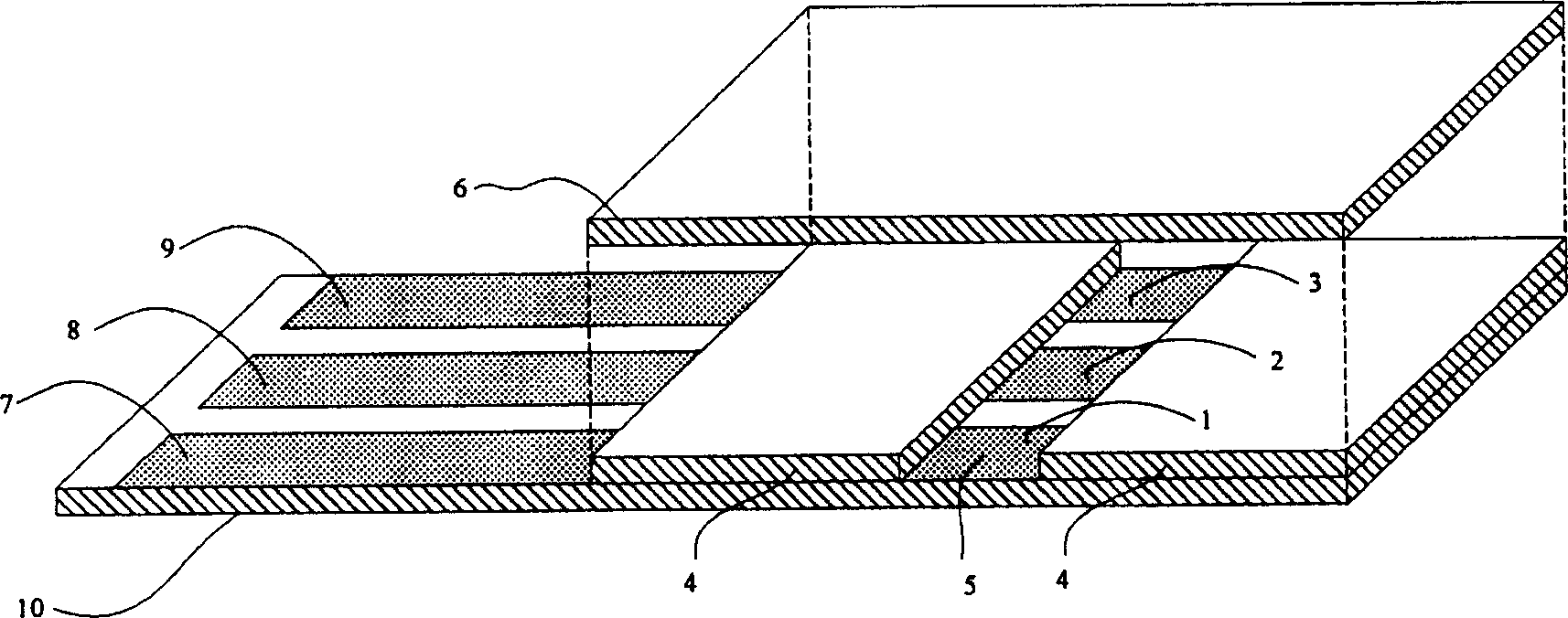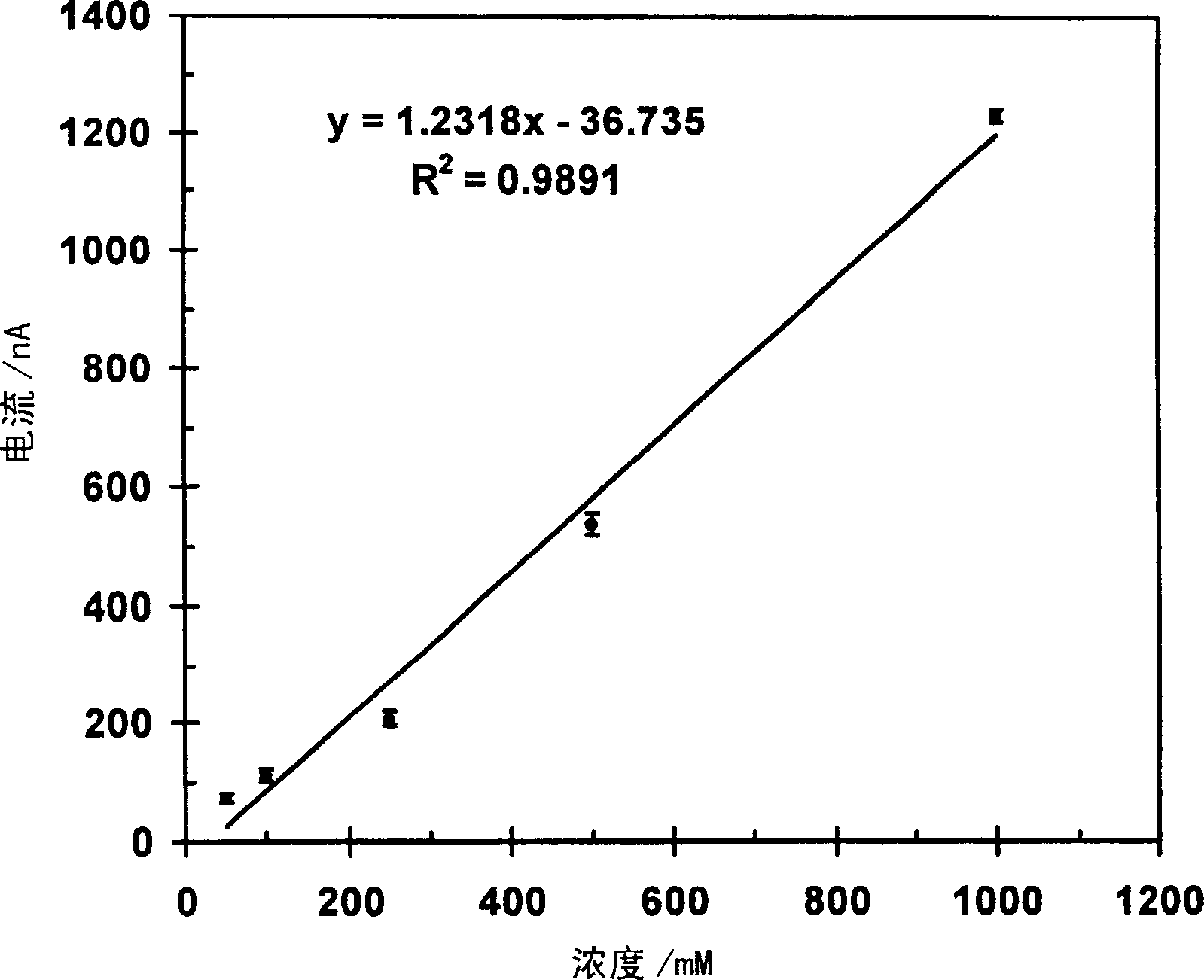Biological sensor for detecting glutamic pyruvic transaminase
Alanine aminotransferase and biosensor technology, applied in the direction of biological testing, microbial measurement/inspection, biochemical equipment and methods, etc., can solve the problems that affect the accuracy and stability of detection, are susceptible to external interference, and are difficult to detect with small currents to achieve high electron transfer efficiency, ensure consistency, and increase the effect of current response signals
- Summary
- Abstract
- Description
- Claims
- Application Information
AI Technical Summary
Problems solved by technology
Method used
Image
Examples
Embodiment 1
[0033] Embodiment one: if figure 1 and figure 2 As shown, the biosensor for detecting alanine aminotransferase of the present invention comprises an insulating substrate 10, which is a polycarbonate sheet with a thickness of 0.5 mm, on which a layer of protective plastic film is pasted by electrostatic force, and a A high-precision film engraving machine engraves the pattern of the masking mask of the thin-film electrode required, and deposits a gold film on the substrate 10 through the metal film deposition process, with a thickness of about 100nm. After removing the masking mask, a flat metal film can be formed Electrode, one end of the film electrode is used as the access end of the insertion detection instrument: access end 7, access end 8 and access end 9, and a spacer 4 with a thickness of 0.125mm is pasted on the electrode surface of the other end, spacer 4 A reaction channel 5 (4.0mm×8.0mm) is engraved on it, and the electrode systems in the reaction channel 5 are re...
Embodiment 2
[0037] Example 2: 18 μl of alanine aminotransferase (GPT) reaction reagent was added to a 0.5 ml centrifuge tube. The reagent contains 0.01M disodium hydrogen phosphate-sodium dihydrogen phosphate with a pH value of 7.4. The buffer contains 0.1% triton (TX-100), 2U / ml glutamic acid oxidase, 10mM alginic acid Sodium, 10mg carboxymethyl cellulose (CMC) is dissolved and made the mixed solution. Then add 2 μl of alanine aminotransferase (GPT) solution of different concentrations. After 2 minutes of reaction, add the solution in the centrifuge tube dropwise to the electrode in the reaction channel 5 of the sensor, apply 0.0V voltage across the working electrode 2 and reference electrode 1, and read the reaction value after 60 seconds. current. Each GPT concentration was measured three times with different sensors.
[0038] The sensor adopts the above-mentioned manufacturing method, but no reaction reagent is added. Experimental results such as image 3 , when the concentration...
Embodiment 3
[0039] Example 3: 20 μl of alanine aminotransferase (GPT) reaction reagent was added to a 0.5 ml centrifuge tube. The reagent contains 0.01M disodium hydrogen phosphate-sodium dihydrogen phosphate with a pH value of 7.4. The buffer contains 0.1% triton (TX-100), 2U / ml glutamic acid oxidase, 10mM alginic acid Sodium, 10mg carboxymethyl cellulose (CMC) is dissolved and made the mixed solution. Dry in a constant temperature drying oven at 35°C for 24 hours. Take 20 μl of human serum sample and add it to a centrifuge tube containing dry reagents, stir well, and after 2 minutes of reaction, add the solution in the centrifuge tube dropwise to the electrode in the reaction channel 5 of the sensor, between the working electrode 2 and the reference electrode 1. Apply a voltage of 0.0V to both ends, and read the corresponding current after 60 seconds. response curve as Figure 4 . The response current of 3U / l GPT is 39.8nA, and the response current of 112U / l GPT is 104.9nA, thus, th...
PUM
 Login to View More
Login to View More Abstract
Description
Claims
Application Information
 Login to View More
Login to View More - R&D
- Intellectual Property
- Life Sciences
- Materials
- Tech Scout
- Unparalleled Data Quality
- Higher Quality Content
- 60% Fewer Hallucinations
Browse by: Latest US Patents, China's latest patents, Technical Efficacy Thesaurus, Application Domain, Technology Topic, Popular Technical Reports.
© 2025 PatSnap. All rights reserved.Legal|Privacy policy|Modern Slavery Act Transparency Statement|Sitemap|About US| Contact US: help@patsnap.com



